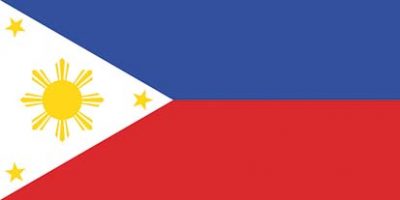 The Port of Manila (Pantalan ng Maynila in Filipino) is the main port on Manila Bay, one of the finest natural harbours in Asia, with many piers and terminals that serve the Metro Manila area. However, it is managed by the State owned Philippine Ports Authority (PPA), with collective responsibility for all of the ports of the Philippines, and administered in the five broad areas of Manila/North Luzon, Batangas/South Luzon, Visayas (the central eight islands or groups of islands), Northern Mindanao and Southern Mindanao. Manila is a large, busy port with 4.75 million TEU of containers handled per annum in 2016 and a total of 75 million tonnes of cargo, while all of the PPA ports handle a much larger total of 6.574 million TEU of containers and 250 million tonnes per annum (96 million tonnes domestic cargo and 154 million tonnes of foreign trade cargo). In the early 1970s, there were over seven hundred State owned and privately owned ports in the Philippines, with the PPA formed in December 1975 as a central management body for all of the ports of the Philippines, the two biggest being Manila and Batangas. The Port of Manila is located at 14-38 degrees North, and 120-58 degrees East.
The Port of Manila (Pantalan ng Maynila in Filipino) is the main port on Manila Bay, one of the finest natural harbours in Asia, with many piers and terminals that serve the Metro Manila area. However, it is managed by the State owned Philippine Ports Authority (PPA), with collective responsibility for all of the ports of the Philippines, and administered in the five broad areas of Manila/North Luzon, Batangas/South Luzon, Visayas (the central eight islands or groups of islands), Northern Mindanao and Southern Mindanao. Manila is a large, busy port with 4.75 million TEU of containers handled per annum in 2016 and a total of 75 million tonnes of cargo, while all of the PPA ports handle a much larger total of 6.574 million TEU of containers and 250 million tonnes per annum (96 million tonnes domestic cargo and 154 million tonnes of foreign trade cargo). In the early 1970s, there were over seven hundred State owned and privately owned ports in the Philippines, with the PPA formed in December 1975 as a central management body for all of the ports of the Philippines, the two biggest being Manila and Batangas. The Port of Manila is located at 14-38 degrees North, and 120-58 degrees East.
History Of Manila
The Manila area dates back to the pre-Spanish rule of the islands, with trade relations with most of the neighbouring island groups dating back to the ninth century A.D. Major trading partners included the Dutch East Indies, Japan and China with also trading to the more distant India and Middle East regions. Attacks by the Sultan of Brunei led to his rule and fortification of Manila on the Pasig river in the thirteenth century. The Spanish arrived and settled in the central islands of Cebu Island and Panay Island in the early sixteenth century, with Governor Miguel Lopez de Legazpi forced to attack in 1570 the forces of the Sultan of Brunei ensconced in Manila as the Sultan would not submit to Spanish rule. The Spanish succeeded in capturing Manila, brushing aside any signs of resistance in the surrounding areas, and in 1571 the Colony of the Philippines was declared as part of Spain.
The Spanish Governor General of Manila ruled the islands but was subordinate to his counterpart of the Viceroy of Mexico City. The Spanish shipped large quantities of gold and silver from the Caribbean area back to Cadiz at this time as well as trading between the Caribbean and the Philippines. A Chinese force of ships with three thousand men attacked Manila in 1574, but after their defeat, the Spanish rulers forced the Chinese that were already resident in Manila into separate districts. Manila was declared the capital of the Philippines in 1596, and a municipal government was established in the town with the Spanish ruling community called Intramuros (‘Inside the Walls’) with heavily fortified walls. This Intramuros area is today the oldest district of Manila, and is on the south side of the Pasig river with its high stone walls intact. It is the best place to visit in Manila for anyone with a knowledge of Spanish history.
The British occupied Manila for a brief two years during the early 1760s, the Spanish fled after destroying their instruments of government and their valuable historic documents, but the Philippines were restored to the Spanish Crown in 1763 under the Treaty of Paris. However, dissent of Spanish rule grew in the mid 1890s with much anti-Spanish propaganda distributed to the population of Manila, with an open rebellion on the streets in 1896. The leader of the revolution, Jose Rizal, was executed by firing squad against a wall in the main street of Manila after months of fighting and the formation of a revolutionary government opposed to Spanish rule. However, after only two further years of rule, Spanish forces were defeated by American forces during the Spanish – American War of 1898. Admiral George Dewey of the U.S. Navy defeated the Spanish warships in the Battle of Manila Bay, and the subsequent peace treaty ended three centuries of Spanish rule.
Discontent continued under American rule, and a year later in 1899 a war broke out between the Americans and the Filipinos, leading to the defeat of the Filipino troops under General Aguinaldo in 1901. The Filipinos continued to resist American occupation of their island with a guerrilla war, which was brutally and bloodily suppressed by the Americans over a long period. A policy of ‘deferred independence’ was the solution to the dilemma of the Americans.
General Douglas MacArthur (1880-1964) sailed into the Port of Manila in late October 1922 to assume command of the Military District of Manila. He quelled a mutiny in 1924, and subsequently became friends with the later Philippine President, Manuel L. Quezon. The Philippines achieved semi-independence from the United States in 1935 under their new President Quezon, who became the first Philippine President to occupy the Malacanang Presidential Palace on the Pasig river. President Manuel Quezon during his presidency asked General Macarthur to supervise the creation of a regular Philippine Army, becoming its first Five Star General and Field Marshal.
General MacArthur stayed in the penthouse suite of the Manila Hotel during his tenure from 1935 to 1941 as the Military Adviser of the Philippine Commonwealth. Construction of this white stucco hotel, designed in ‘California Mission’ style architecture, took place between 1909 and its opening on 4th July 1912 to commemorate American Independence Day. It was built on 35,000 square metres of reclaimed land at the north west end of Rizal Park, and was the centre of American social life in Manila. It survived the war, although badly damaged, and was rebuilt in 1975 with a tall tower hotel building behind the original restored hotel, and now has 570 rooms, all with fabulous views over Manila Bay. Today, one can stay in his (General MacArthur’s) suite for a cool US $650 for one night.
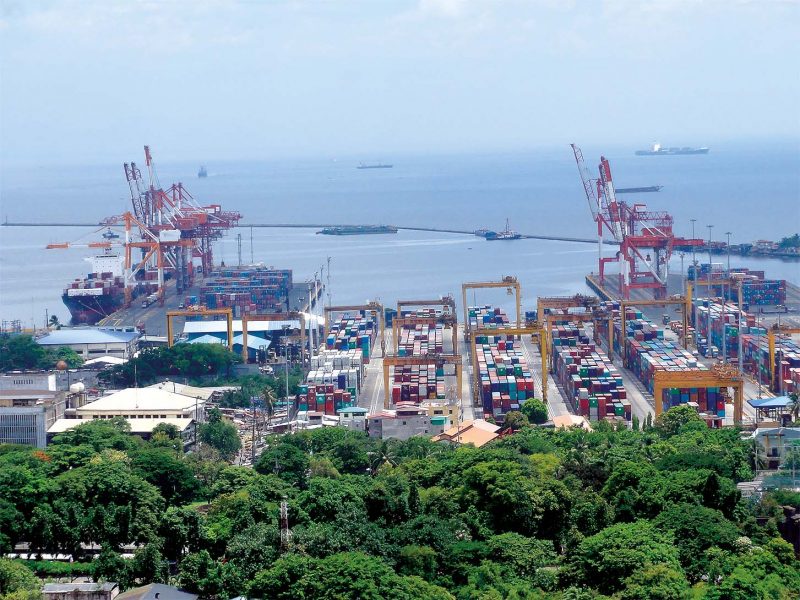
The Japanese Army bombed the Port of Manila during their first big thrusts into the Pacific area in December 1941. A surprise attack of an aerial bombardment of Manila just ten hours after the destruction of Pearl Harbour was followed by troop landings to the north and south of Manila as well as the destruction of American warplanes at their air bases. The Port of Manila was declared an open city in the hope of sparing further damage from the Japanese, and the Americans were asked to withdraw. On 2nd January 1942, the Japanese Imperial Army marched into the city, and established a new Government to rule the city with a Philippine Executive Commission of Filipinos willing to co-operate with the Japanese, which was later extended to the whole country.
General Douglas MacArthur moved his troops into the Bataan peninsula for two months with an heroic delaying action. The fortified rock strewn island of Corregidor in Manila Bay became the last stand until capitulation on 9th April 1942. This resulted in thousands of American and Filipino troops beginning the infamous ‘Bataan Death March’ to their imprisonment on Camp O’Donnell. General MacArthur was forced to retreat to Mindanao, the southernmost island of the country, and was ordered to board an American transport plane at Del Monte airfield for Australia on 12th March 1942. As he boarded the plane, he issued his famous quote ‘I came through, and I shall return’. President Quezon and Vice President Osmena left for the United States, and set up a Philippine Government in exile, with President Quezon dying in exile in August 1944.
General MacArthur returned in force in October 1944, and after a bloody battle in the Intramuros District of Manila lasting 29 days, the heavily devastated Port of Manila was liberated by American and Filipino troops at a terrible cost of 117,000 lives (100,000 civilians, 16,000 Japanese and one thousand American lives). Manila was a scene of utter devastation, as it had become the most heavily damaged and destroyed city of World War II, except for Warsaw in Poland. The Port of Manila took many years to rebuild, after the flag of the Republic of the Philippines was raised for the first time on 4th July 1946 in Rizal Park in Manila.
The leadership of the country was however unstable, with various factions jostling for power until President Ferdinand Marcos (1917-1989) came to power as President in 1965, and he remained in power until 1986. In the early 1970s, students and workers demanded land reforms and an end to political corruption and American influence. President Marcos declared martial law in September 1972, which lasted until 1981. During his rule, the country almost disintegrated into anarchy with tens of thousands of dissenters disappearing and killed in a similar situation to the Argentinean Generals rule of that country. Finally, the widow of opposition leader Benigno Aquino was installed as President in 1986 after her husband had been killed as he disembarked from his aeroplane on arrival in Manila in 1983. Since the 1990s, the administrators of the city of Manila have eradicated some of the crime and electoral fraud, and have fought for better education and social welfare for its growing population. A majority of 90% of the population of the Philippines are Roman Catholic of Malay origin, while 9% are Protestants, and the remaining one percent are mostly Muslim in Mindanao island in the south.
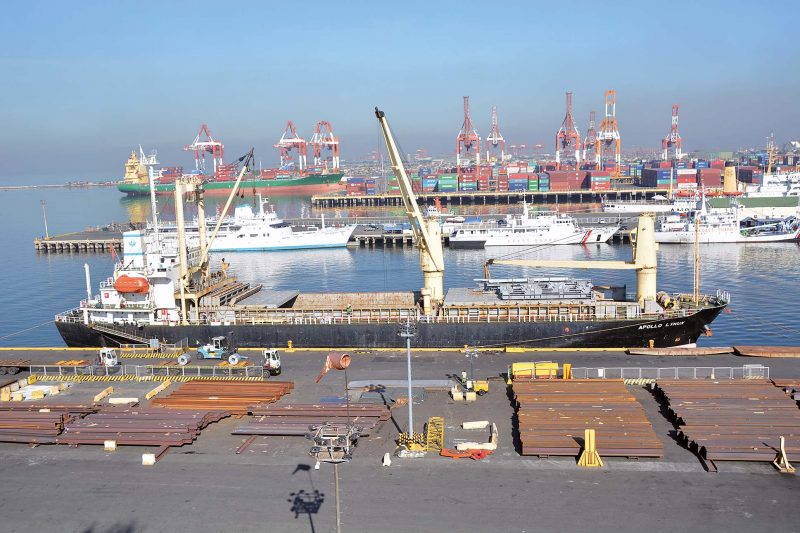
Port Of Manila Facilities
Manila Bay is twelve miles wide at its entrance and expands to a width of thirty miles. Mariveles, in the province of Bataan, is an anchorage inside the northern entrance, and Sangley Point is the former location of Cavite Naval Base to the south. The Bataan peninsula is twenty five miles to the north, with Manila Bay ringed by volcanic peaks and tropical foliage. The State owned PPA was given financial autonomy and the additional responsibility for the construction of new port facilities in 1987 by the Government of the Republic of the Philippines. The Port of Manila facilities are split into three areas each managed by a different company:-
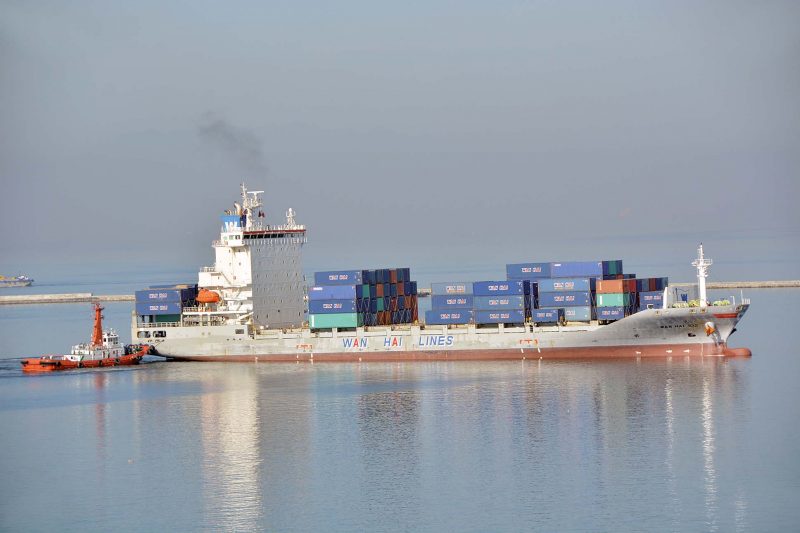
Manila North Harbour
A 53 hectare area in the Tondo area of Manila to the north of the Pasig river, which today uses the Port of Manila pier even numbers and has Piers 2, 4, 6, 8, 10, 12 and 14 in use, with Pier 2 having been the berth since 1932 of the oldest passenger company in the Philippines, Negros Navigation Co. Inc. until 2012. All of these piers are very wide, with most having cranes on both sides and the middle section used for the storage of cargo. A new North Port Passenger Terminal has since replaced the old terminal for passengers. This is the largest port in the Philippines for domestic passenger and cargo traffic, and is a joint venture between Harbour Centre Port Terminal Inc, the largest port operator in the Philippines, and the Petron Corporation of the oil sector. The total length of the quays is 5,200 metres with alongside depths of between 9 and 11 metres. Recent projects include rail crane development, rehabilitation of the container yard, construction of an electrical power centre, the large new North Port Passenger Terminal, and the rehabilitation of Pier 4.
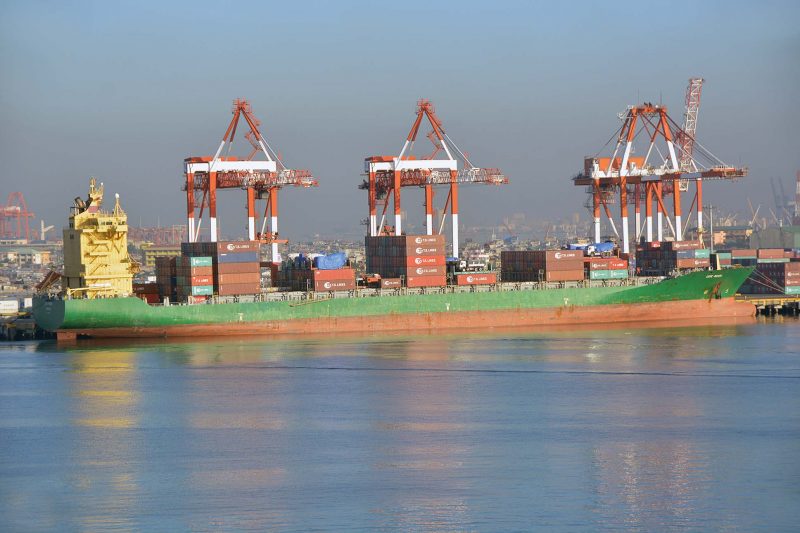
Manila South Harbour
An 85 hectare area to the south of the Pasig river, which today uses the Port of Manila pier odd numbers with Piers 3, 5, 9, 13 and 15 in use, as well as the Eva Macapagal Passenger and Cruise Terminal between Piers 13 and 15. The total length of the quays is 2,500 metres with alongside depths of between nine and eleven metres. Manila South Harbour is operated by Asian Terminals Inc, a Philippines port investor and operator handling general cargo, bulk cargo, ro-ro cargo as well as passengers. Manila South Harbour is protected by rock barriers that enclose around six hundred hectares of anchorage, with eighteen anchorage berths available for discharge into barges. Piers 9 and 13 handle general cargo, timber, steel, livestock, grains, and heavy lift project cargo with the warehouses behind being of 8,500 square metres in area. A Liebherr mobile crane was installed in 2014, and a floating crane of 65 tonnes capacity and other land based cranes are available.
Manila South Container Terminal operational area includes Piers 3 and 5 with seven berths with a total quay length of 975 metres. This terminal has automated entry and exit gates and container weighing bridges, a container storage area of thirty hectares, reefer plug separate areas, seven high capacity tall gantry cranes, many rubber tyred mobile gantry cranes, reach stackers, loaders, heavy tractors and several mobile container X-ray machines that can determine the nature of its contents before a manual ‘break-in’ is authorised. Container lines calling include many Japanese lines including NYK, as well as Hyundai Merchant Marine of South Korea, MCC Transport of Singapore, Pacific International Lines (PIL) of Singapore, and SITC Container Lines and many other Asian shipping companies.
The Eva Macapagal Passenger and Cruise Terminal is the newest and largest passenger terminal in the Philippines. It covers 2,878 square metres in area with facilities for inter island and cruise passengers, including an air conditioned passenger lounge with seats for 1,700 travellers with cafes, television, public telephones and large restrooms. It is also the landing point for the port pilots, customs officials, quarantine officers and transfer workboats operating between the anchorage berths and the port.
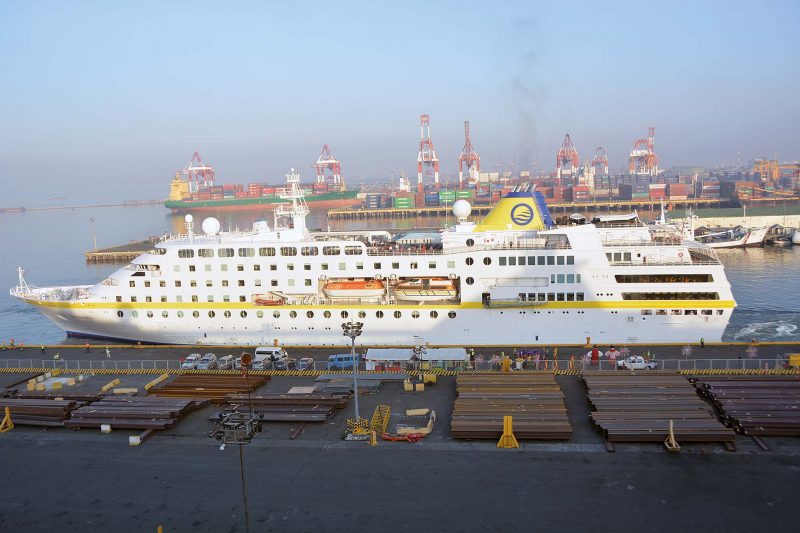
Manila International Container Terminal (MICT)
This large container terminal is located on the large port rectangular extension area that projects to seaward on the north side of the Pasig river, and lies between Manila North Harbour and Manila South Harbour. It opened for business in 1988 and is operated by ICTSI (International Container Terminal Services Inc.) and is a very busy container terminal handling 3.5 million TEU of containers per annum, with Berth 6 inaugurated to increase the terminal capacity by 450,000 containers on 7th July 2012. Berth 7 Phase 1 construction has recently been completed to increase terminal container throughput by 18%. Inland container depots at the Laguna de Bay area and intermodal freight trains on the Manila to Calamba route increase the annual capacity of MICT by 250,000 TEU.
Ten tall high capacity gantry cranes each guarantee thirty container moves per hour, with in addition forty mobile rubber tyred gantry cranes, ten container weighbridges, fifteen reach stackers, ninety prime movers, and 180 mobile tractors. Non container and general cargoes are also handled at its basin anchorage with two mooring buoys, grain elevator and vacuum machinery, and other discharging and loading equipment.
The approach channel to the port has been dredged to a depth 9.4 to 10.0 metres, with alongside depth at MICT between 11.0 and 12.2 metres, although the anchorage has only a depth of 4.9 metres and 6.1 metres.
Severe congestion at MICT occurred during 2014 with 10% of the 900,000 empty containers handled per year overstaying their welcome by over three months, leading to severe quay and port congestion with a truck ban operating during daylight hours.
Many container lines moved to the Batangas container terminal extension or the Subic Bay Freeport, but happily congestion at the Port of Manila container terminals and quays has now been reduced.
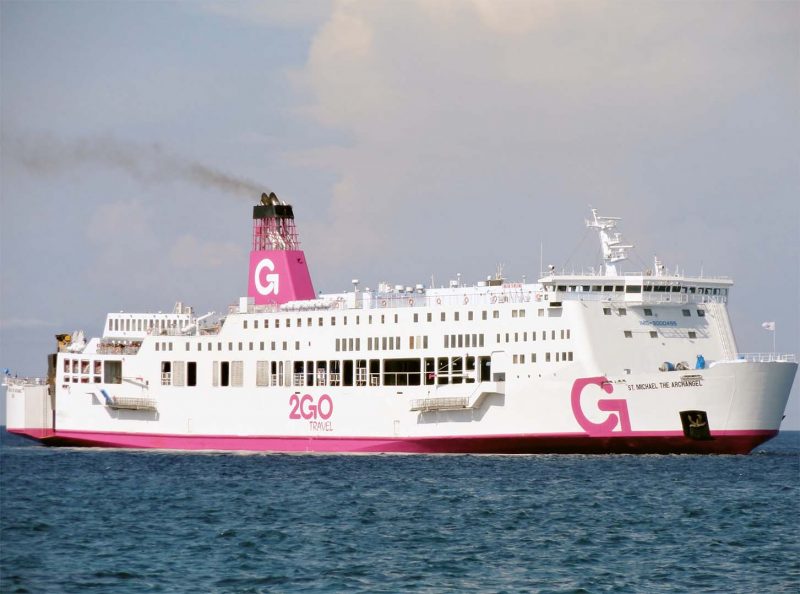

Manila Bay Ferry Lines Negros Navigation Co. Inc.
The oldest and most well known of the passenger ferry lines transitting Manila Bay is Negros Navigation Co. Inc., founded on 26th July 1932 in Manila for the purpose of transporting passengers and cargo into Manila, as well as five ports in the Visayas central islands, and eight ports in the southern Mindanao island. Pier 2 in Manila North Port was its hub from the start, and it quickly gained a reputation for the operation of good quality passenger vessels. Air conditioning became standard on its fleet of five passenger ships in 1973 in Don Juan 2,311/71, Don Julio 2,116/67, Don Vicente 1,070/69, Dona Floretina 2,095/65 and Princess of Negros 507/62. A new and modern passenger terminal was in operation in Manila North Port in 1975, with special cruises run from it to tourist attractions throughout the Philippines.
On 22nd April 1980, the passenger vessel Don Juan bound for Bacolod City collided 20 nautical miles off Maestre de Campo Island near Mindoro Island with the tanker Tacloban City, with eighteen people killed, 115 missing, and 745 survivors. Ro-ro and small feeder container ships ushered in a new arm of the company in the 1980s, but the main thrust was always passenger vessels, with company shuttle buses meeting the vessels at most ports e.g. Baclaran, Cubao and Alabang. An Initial Public Offering (IPO) in 1995 after a listing was obtained on the Manila Stock Exchange brought in 916.86 million in Philippine pesos. A total of nine ships was being operated in 1998/99, with six passenger vessels in Don Julio 1,470/67, Saint Francis of Assisi 2,034/75, Saint Paulia 1,982/71, San Lorenzo Ruiz 2,988/73, St. Peter the Apostle 2,700/76, St. Joseph the Worker 6,090/76 as well as the ro-ro Santa Ana 1,566/73, the coaster Connie II 2,027/71 and the feeder container ship San Sebastian 4,432/70.
The Government of the People’s Republic of China gained a controlling interest in the company in 1996 with an equity injection, and in 2012 retired the Negros Navigation brand in favour of new image company of ‘2GO’ with faster craft. The flagship passenger vessel St. Michael the Archangel 17,781/90 was purchased in May 2011 and given a red funnel with the ‘2GO’ logo, and runs alongside the similar capacity sized ferry St. Francis Xavier 11,200/91.
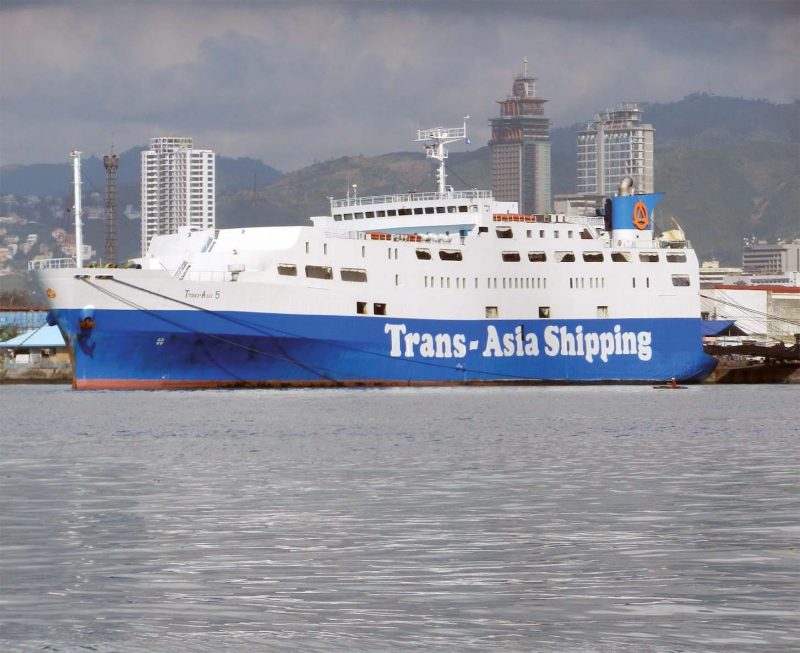
Trans-Asia Shipping Lines Inc. (Tasli)
A fleet of nine blue hulled ro-paxes and cargo ships with blue funnels carrying a yellow logo currently run on the route from Manila to Cebu City. The company was formed on 25th March 1974 at Cebu City as Solar Shipping Lines Inc., but changed its name seven months later to Trans-Asia Shipping Lines Inc. (TASLI) on 16th October 1974. A fleet of four small coastal passenger vessels were being traded in 1998, all with ‘Asia’ prefixes to their names e.g. Asia Princess. Seven twin funnelled former Japanese ro-paxes have since been purchased, along with two small cargo ships. The ro-paxes are Trans-Asia 2 of 1,389 grt built in 1977, Trans-Asia 3 of 2,908 grt built in 1989, Trans-Asia 5 of 4,790 grt built in 1989 with a draft of 7.15 metres and a service speed of 14.0 knots, Trans-Asia 8 of 2,019 grt built in 1984, Trans-Asia 9 of 5,463 grt built in 1979, Trans-Asia 10 of 3,998 grt built in 1979, as well as the coastal passenger ship Asia Philippines 413/75.
The two cargo ships are the bridge forward, engines aft Asia Pacific 1,377/81 carrying 1,080 tonnes of cargo on a draft of 4.0 metres, and the small feeder container ship Trans-Asia 12 carrying 175 TEU.
Manila Bay Container Lines
Top twenty deep sea container lines such as American President Lines (APL) call regularly at Manila through their Intra-Asia Service Networks, with a new CS5 string calling directly at Manila from North and Central China, Korea and Taiwan. There are two inter-island container lines that sail from Manila to Cebu, Tagolan, Davao, General Santos, Iloilo, Bacolod, Dunaguete, Zamboanga and Cotabato. These are Lorenzo Shipping Corporation (LSC), and Oceanic Container Lines Inc. (OCLI).
Lorenzo Shipping Corporation (Lsc)
This company was formed on 17th October 1972 for domestic inter-island cargo and container handling between ten ports from Manila serving the Visayas islands of the Central Philippines and Mindanao Island in the south. A fleet of fifteen general cargo and container vessels and one small passenger and cargo vessel were being traded in 1998, with names having ‘LSC’, ‘Lorcon’, or ‘Lorenzo’ prefixes e.g. LSC Cagayan de Oro of 7,025 dwt and built in 1986. The company has since evolved its fleet into a containerised cargo handling fleet of former Japanese built and owned vessels with grey hulls and green and white funnel colours with a green central logo. Seven small container ships of between 6,000 dwt and 10,000 dwt are currently traded in Lorcon Cagayan de Oro, Lorcon Davao, Lorcon Zamboanga, Lorcon Visayas, Lorcon Cebu, Lorcon Manila and Lorcon Dumaguete.
Oceanic Container Lines Inc. (Ocli)
This company was incorporated on 22nd July 1998 for inter-island container services from Manila throughout the chains of Philippine islands to Davao, General Santos, Zamboanga, Cagayan de Oro, Bacolod, Iloilo, Dumaguete and Cebu. A current fleet of eighteen vessels in the range from 4,000 dwt to 8,500 dwt have blue or black hulls with white funnels bearing the company logo. The fleet is composed of the vessels Ocean Hope, Ocean Faith, Ocean Prosperity, Ocean Nobility, Ocean Blessing, Ocean Serenity, Ocean Victory, Ocean Mighty, Ocean Challenger, Ocean Excellence, Ocean Abundance, Ocean Greatness, Ocean Wisdom, Ocean Opportunity, Ocean Dependable, Ocean Queenland, Ocean Reliable and Ocean Kingdom. All of these vessels are equipped with one or two masts, each equipped with a heavy lift derrick for container handling at island ports with little infrastructure.
Deadliest Maritime Disaster
The deadliest peacetime maritime disaster ever befell the passenger ferry Dona Paz 2,602/63, with no fewer than 4,386 people lost from drowning or being burnt to death on board. There were only two dozen survivors that were able to give an account of the disaster on 20th December 1987. She had a previous bad safety record on 5th June 1979, while named Don Sulpicio of Sulpicio Lines of Manila, the vessel was gutted by fire while on a voyage from Manila to Cebu City. All 1,164 passengers on board were rescued but the vessel was beached and declared a constructive total loss. The wreck was repurchased from the underwriters by Sulpicio Lines, the passenger accommodation was refurbished and she was renamed Dona Paz.
On the night of the disaster, Dona Paz was travelling from Leyte Island to Manila and at 2230 hours was off Dumali Point in the Tablas Strait near Marinduque. She collided with the Caltex tanker Vector carrying gasoline and petroleum products, the collision igniting her cargo. The fire spread onto Dona Paz causing panic among her crew and passengers, with her passenger accommodation quickly gutted by fire and sea around the vessel on fire. Dona Paz had sunk within two hours, and the tanker Vector within four hours in 1,788 feet of shark infested waters. Those passengers that jumped into the sea to escape the massive blaze were burnt to death in the water to join the huge number of charred bodies on the blazing vessel. It transpired that Dona Paz was carrying at least two thousand or more passengers than her passenger certificate allowed, due to the practice of a stampede at boarding time and being able to buy tickets at cut prices on board. This deadliest of all peace time maritime disasters was due to the vessel being seriously overcrowded (Sources are the Board of Marine Inquiry, the Philippine Coast Guard, and the Philippine Daily Inquirer).
Sulpicio Lines had three more major ferry disasters over the next twenty years, with huge loss of life. Dona Marilyn, sister of Dona Paz, sank on 24th October 1988 while on a voyage from Manila to Tacloban City in heavy weather with 389 passengers drowned and 147 survivors. Princess of the Orient sank on 18th September 1998 while on a voyage from Manila to Cebu City in heavy weather off Fortune Island near Batangas. Some 150 passengers were drowned, and 238 survivors were left drifting in the sea for more than twelve hours before rescuers were able to reach them.
Princess of the Stars sailed from Manila on 20th June 2008 with between 700 and 800 passengers en route for Cebu City. The engines failed at midday the following day, and she capsized after a large hole appeared in her hull, with many bodies found floating nearby by the only rescue craft, a speedboat sent by the Mayor of San Fernando. There were only 32 survivors from 752 passengers and 121 crew members.
Sulpicio Lines was suspended by the Government Maritime Industry Authority shortly after this disaster in June 2008, but changed its name to Philippine Span Asia Corporation and carried on transporting passengers, having had five major shipping disasters that had claimed the lives of over five thousand people in twenty years (Sources are the Boards of Marine Inquiry, the Philippine Coast Guard and the Philippine Daily Inquirer). The seas around the Philippine Islands can be dangerous for passenger vessels, including small, wooden ‘bangka’ types as well as larger ferries, being lost due to capsizing, sinking, colliding or from serious fires on board. During the 23 year period from 1980 to 2003, there were 38 serious incidents resulting in the loss of almost six thousand passengers and crew, with a further large number of people missing (Sources are the Boards of Marine Inquiry, the Philippines Coast Guard and the Philippine Daily Inquirer).
Hopefully, newer passenger ships belonging to recently formed companies e.g. Montenegro Lines established in 2006, Cokaliong Shipping Lines established in Cebu City in 1989, Cebu Ferries established in 1994, and Gothong Lines established on 3rd October 2002 as well as the WG&A ‘SuperCat’ and ‘SuperFerry’ fast craft, will have all of their IMO passenger and other certificates and every piece of safety equipment fully checked at regular intervals by trained ship inspectors, with vessels detained until they become safe. This is the only route to be taken by the Philippine ferry industry if it wishes to correct the past.
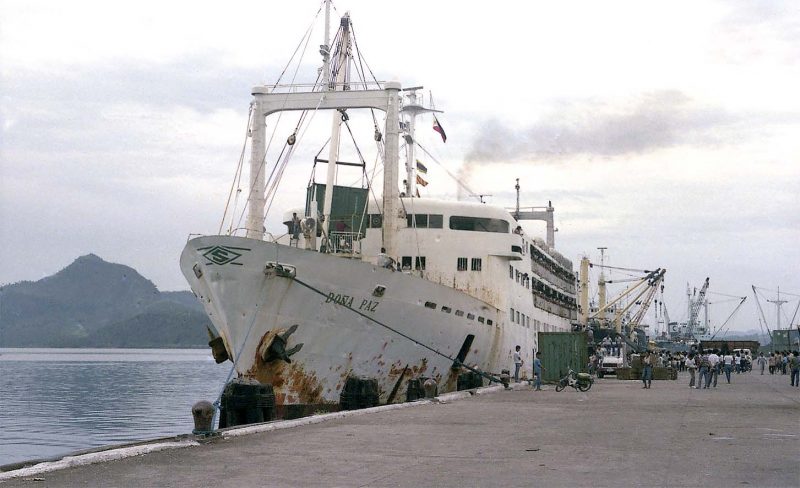
Philippine Oil and Gas Industry
The first oil refinery in the Philippines was completed in 1954 at Batangas to the south of Manila by Caltex with a 72,000 barrels per day capacity. This Batangas refinery was converted in 2004 at a cost of US $13.6 million into a major finished product import terminal in order to position Caltex (Philippines) into a major supplier of the nation’s energy requirements. The Philipinas Shell Petroleum refinery at Tabangao to the south of Batangas was completed in 1962, with the oil throughput later doubled from 60,000 barrels per day to 120,000 barrels per day or the equivalent of six million tonnes per year of oil.
The State owned Philippine National Oil Company (PNOC) was founded in Manila on 9th November 1973 as a direct response to the huge spike in oil prices a few months earlier by the OPEC oil producing nations. President Ferdinand Marcos had declared the country to be under martial law in 1971 and he wished a State owned company to supply oil to the country. Esso (Philippines) Inc. and a majority equity in the Bataan Refining Corporation were acquired in December 1973, along with the deep sea tankers Diego Silang of 97,158 dwt, Sultan Kuparat of 85,837 dwt and Raha Sulayman of 121,795 dwt to meet the requirements of the Middle East oil producers.
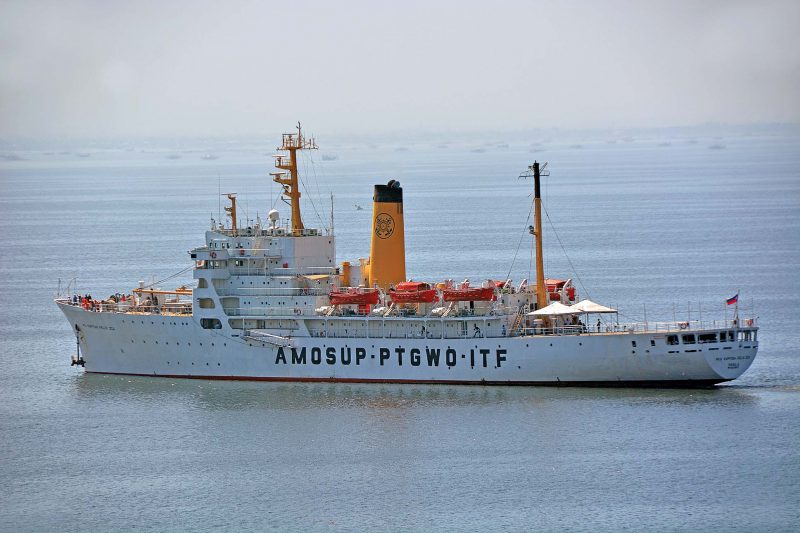
The Philippine Government later constructed or acquired petrochemical complexes refineries e.g. at Limay and Mariveles (Bataan), and purchased the LPG tanker Petron Gasul in 1979 to reduce queuing at Batangas. In 1980/81, four large tankers were acquired, including two VLCCs of 260,000 dwt and 206,970 dwt respectively in Andres Bonifacio and Gregorio del Pilar for the purpose of stockpiling oil to protect the country from adverse oil market conditions. The other pair of tankers were Emilio Aguinaldo of 98,311 dwt built in 1967 and Raha Sikatura of 58,160 dwt and built in 1964. In 1983, PNOC owned eleven deep sea and coastal tankers of 339,776 grt and 691,000 dwt.
The four largest tankers were sold off in 1994, leaving a coastal tanker fleet to transport finished oil products around the ports of the island groups. At the Millennium, PNOC owned a dozen coastal oil tankers of up to 7,500 dwt including PNOC Gomburza, PNOC Petroparcel, PNOC Tabangao, PNOC Taclobo, PNOC Transasia, Petron I, Petron II, and Petron III, as well as the LPG tanker Josefa Gabriela Silang of 735 dwt, and three oil barges of 2,362 dwt named Bacolod City, Davao City and Iloilo City.
PNOC also initiated the exploration of the gas and oil reserves of the Philippines, and began exploring for oil and gas in the seas to the west of the island of Palawan in the Spratly Islands in 1976. However, complaints from the Chinese Government halted exploration after gas in commercial quantities had been found, with production of natural gas finally beginning in 2001. Today, it is the only operational offshore platform operating in the Philippines, extracting gas from the Camago-Malampaya gas field, located fifty miles west of Palawan, and conveyed through a 500 kilometre undersea pipeline to Batangas City, where it is fed into an electricity generation system that generates 2,700 megawatts with gas flowing until at least the year 2022. PNOC, Shell and Chevron Texaco are joint partners in the Malampaya gas field.
A second commercial natural gas find was made on land in July 2015 at Santiago City in Northern Luzon, with land based oil and gas projects far easier to develop than offshore projects, and another 500 kilometre pipeline delivers the gas southwards to Batangas. PNOC is also making a big effort to find oil or gas in six more offshore and land based projects, and has chartered exploration rigs to search for oil and gas in the offshore seas around Mindoro Island and other offshore areas. PNOC also owns a commercial oil and gas port at Mabini Energy Supply Base at Batangas, which provides for the berthing of tankers, oil and gas handling, and tank storage facilities.
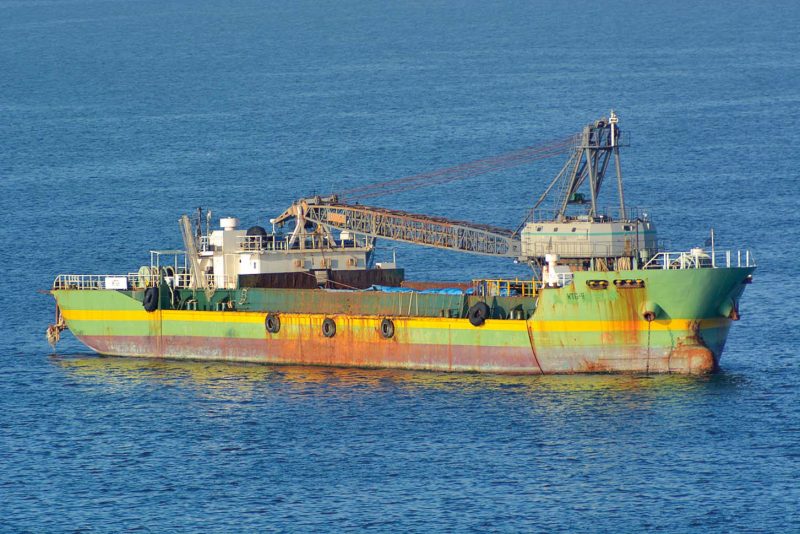
Postscript
The Head Office of the Philippine Ports Authority (PPA) is located in the Philippine National Railways (PNR) Building on Muelle de San Francisco Street behind Piers 13 and 15 in the South Harbour of Manila between the 17th and 20th Street grid intersections.
The PPA has a fleet of six suction, cutter, grab and drag dredgers built in the 1980s of 2,160 tonnes hopper capacity to keep open the channels of all of the ports of the Philippines, including the Port of Manila.
Manila harbour tugs include those owned by the North Harbour Tugs Corporation (NHTC) established on 28th February 1994 by a partnership of the major shipping lines operating to the Port of Manila including ATS Superferries. The tug Iroquois of 198 grt and 3,000 bhp was built in Japan in September 2004 and has a crew of nine.
The beauty of Manila Bay is best appreciated from the upper storeys of the white stucco Manila Hotel, which is not too far from the old colonial ‘city within a city’ of the Spanish Intramuros district. It served for three hundred years as the only Spanish bastion in the Far East, and today over four hundred years later it still has the feel of a medieval fortress with massive gates, moats, and cobblestone streets that echo with horse drawn carriages and phaetons.
The Port of Manila is a very go-ahead business handling the imports and exports of this Philippine Far Eastern port, including textiles, chemicals, clothing, electronics, watches, leather goods, iron and steel, timber and plywood, rope, refined sugar, copra and coconut oil, foodstuffs and beverages of all types.

I wish to thank the website of the Port of Manila at www.ppa.com.ph.





Comments
Sorry, comments are closed for this item